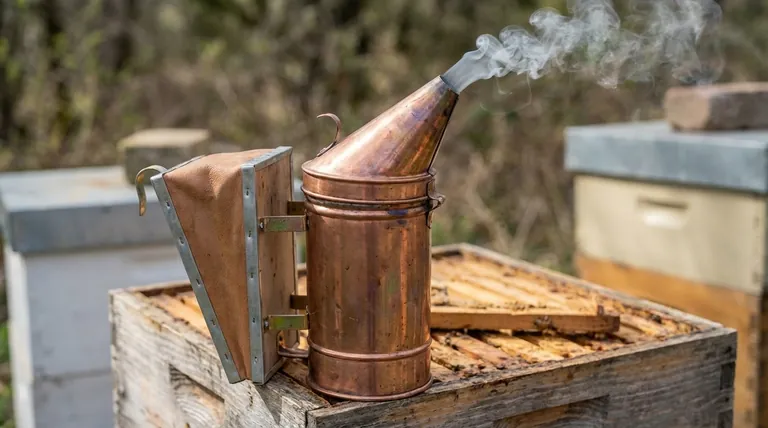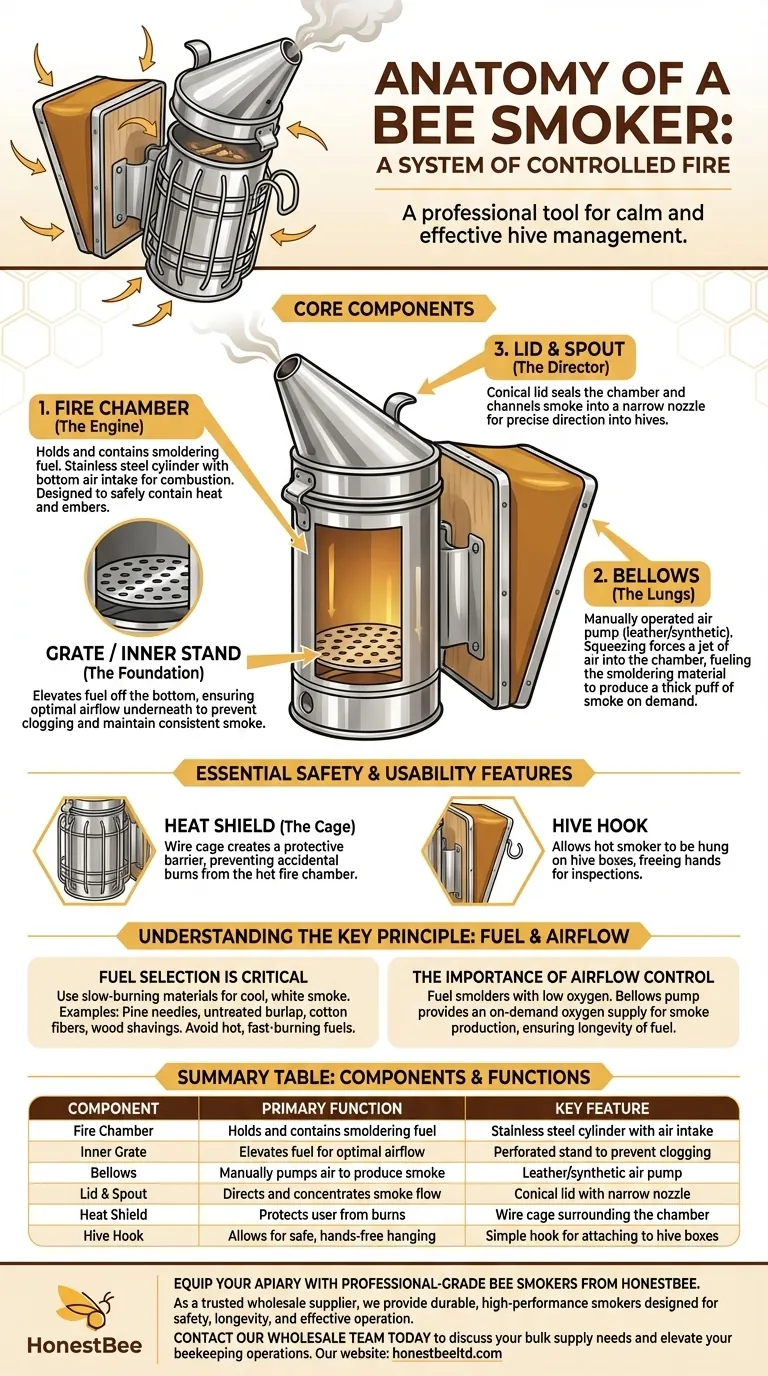At its core, a bee smoker is a simple, manually operated device with three main parts. It consists of a fire chamber to hold smoldering fuel, a set of bellows to pump air, and a spout to direct the resulting smoke. The entire design is engineered to create a steady supply of cool, thick smoke on demand, rather than an open flame.
A bee smoker is not just a can for fire; it is a carefully designed system for airflow control. Each component works together to maintain a slow-burning, oxygen-starved fire that can be instantly activated with the bellows to produce the calm, cool smoke necessary for safe hive inspections.

The Anatomy of a Bee Smoker: A System of Controlled Fire
To understand how a smoker works, you must see its components as an integrated system for managing a small, contained fire.
The Fire Chamber (The Engine)
The fire chamber, typically a stainless steel cylinder, is the heart of the smoker. This is where the fuel is placed and burned. Its solid construction is designed to contain the heat and embers safely.
A small opening at the base of the chamber allows air from the bellows to enter, fueling the combustion process from the bottom up.
The Grate or Inner Stand (The Foundation)
Inside the fire chamber, you will almost always find a perforated grate or a small metal stand. This piece is not just an accessory; it is crucial for proper function.
This grate elevates the fuel off the bottom of the chamber, ensuring that the air pumped in from the bellows can circulate underneath the fuel. This prevents the air intake from getting clogged with ash and allows for consistent, reliable smoke production.
The Bellows (The Lungs)
The bellows are the manually operated air pump attached to the side of the fire chamber. They are typically made of leather or a synthetic equivalent and wood or plastic plates.
When you squeeze the bellows, they force a jet of air into the bottom of the fire chamber. This sudden supply of oxygen causes the smoldering fuel to flare up momentarily, producing a thick puff of smoke that is then forced out the top.
The Lid and Spout (The Director)
The lid, often conical in shape, seals the top of the fire chamber. Its primary job is to channel the smoke into a narrow spout or nozzle.
This design concentrates the smoke and allows the beekeeper to direct it precisely where it's needed—whether into the hive entrance or between the frames of a brood box.
Essential Safety and Usability Features
Beyond the core functional parts, quality smokers include features designed for beekeeper safety and convenience.
The Heat Shield (The Cage)
Most smokers are surrounded by a wire cage or heat shield. The fire chamber can become extremely hot during use, and this shield creates a protective barrier that prevents you from accidentally touching the hot surface and suffering a serious burn.
The Hive Hook
A small hook is often attached to the smoker, usually on the bellows or the heat shield. This simple feature is incredibly useful, allowing you to hang the hot smoker on the side of a hive box or a dedicated holder, freeing your hands for inspections.
Understanding the Key Principle: Fuel and Airflow
A smoker's effectiveness is not just in its construction, but in how it's used. The goal is never a hot, roaring fire.
Fuel Selection is Critical
The best fuels—such as pine needles, untreated burlap, cotton fibers, or wood shavings—are those that smolder slowly and produce large volumes of cool, white smoke. Materials that burn too hot or fast can agitate the bees or even pose a fire hazard.
The Importance of Airflow Control
The smoker is designed to keep the fuel smoldering with very little oxygen. It only produces significant smoke when you pump the bellows. This on-demand system gives you complete control and ensures the fuel lasts for the duration of your inspection.
Making the Right Choice for Your Goal
When selecting or using a smoker, consider what aspect is most important for your beekeeping practice.
- If your primary focus is safety: Prioritize a smoker with a robust, fully welded heat shield and a secure lid that won't open accidentally.
- If your primary focus is performance and longevity: Look for high-quality stainless steel construction and an integrated perforated stand to ensure optimal, clog-free airflow.
- If your primary focus is effective operation: Master the art of lighting your smoker with proper kindling and using slow-burning fuel to produce cool, white smoke on demand.
Understanding these components transforms the bee smoker from a simple can into a precise tool for calm and effective hive management.
Summary Table:
| Component | Primary Function | Key Feature |
|---|---|---|
| Fire Chamber | Holds and contains smoldering fuel | Stainless steel cylinder with air intake |
| Inner Grate | Elevates fuel for optimal airflow | Perforated stand to prevent clogging |
| Bellows | Manually pumps air to produce smoke | Leather/synthetic air pump |
| Lid & Spout | Directs and concentrates smoke flow | Conical lid with narrow nozzle |
| Heat Shield | Protects user from burns | Wire cage surrounding the chamber |
| Hive Hook | Allows for safe, hands-free hanging | Simple hook for attaching to hive boxes |
Equip your apiary with professional-grade bee smokers from HONESTBEE.
As a trusted wholesale supplier for commercial apiaries and beekeeping equipment distributors, we provide durable, high-performance smokers designed for safety, longevity, and effective operation. Our equipment ensures you can conduct calm and productive hive inspections.
Contact our wholesale team today to discuss your bulk supply needs and elevate your beekeeping operations.
Visual Guide

Related Products
- Premium Traditional Copper Bee Smoker with Bellows
- Stainless Steel Honey Bee Smoker Hive and Honeycomb Smoker for Beekeeping
- Stainless Steel Electric Beehive Smoker for Beekeeping and Bee Keeper Use
- European Stainless Steel Bee Smoker for Honey Bee Hive
- Economy Galvanized Beekeeping Honey Bee Smoker for Wholesale
People Also Ask
- What are the main components of a bee smoker? A Guide to Safe and Effective Hive Management
- What are the main parts of a bee smoker? Essential Components for Calm Hive Management
- What is the primary purpose of using smoke in beekeeping? Calm Bees for Safer Hive Management
- What are the benefits of using smoke properly in beekeeping? Achieve Calm, Safe Hive Inspections
- What happens to bees when they sense smoke? Unlock the Secret to Calm Hive Inspections



















